Legal Studies: Misrepresentation and Remedies
VerifiedAdded on 2022/11/18
|12
|3541
|419
AI Summary
This article discusses misrepresentation and remedies under English law, the law of agencies, and common law misrepresentation. It also applies these concepts to case studies involving contracts and agreements.
Contribute Materials
Your contribution can guide someone’s learning journey. Share your
documents today.
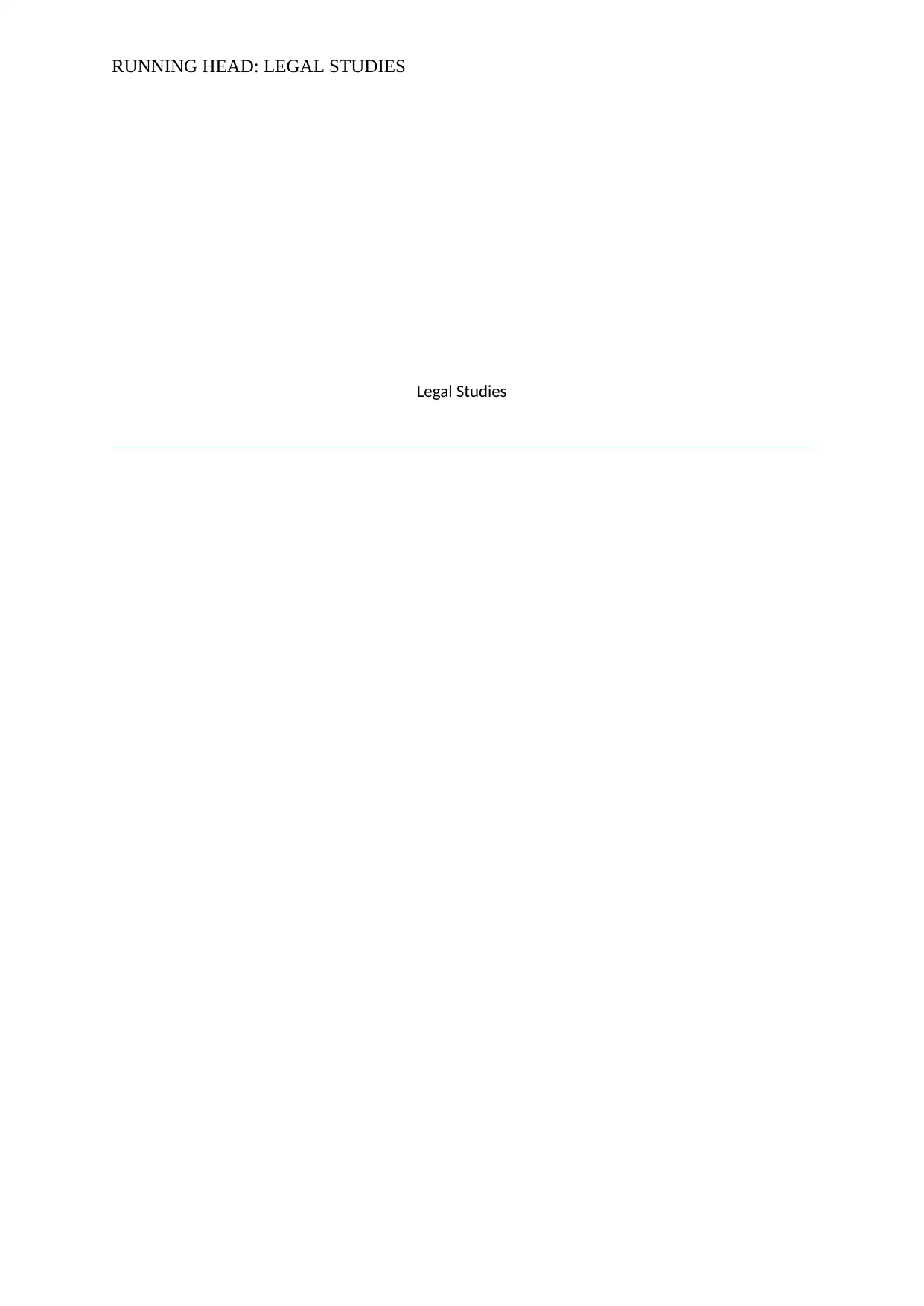
RUNNING HEAD: LEGAL STUDIES
Legal Studies
Legal Studies
Secure Best Marks with AI Grader
Need help grading? Try our AI Grader for instant feedback on your assignments.

LEGAL STUDIES
Contents
Answer 1....................................................................................................................................1
(A)..........................................................................................................................................1
(B)..........................................................................................................................................4
Answer 2....................................................................................................................................6
Bibliography...............................................................................................................................9
1
Contents
Answer 1....................................................................................................................................1
(A)..........................................................................................................................................1
(B)..........................................................................................................................................4
Answer 2....................................................................................................................................6
Bibliography...............................................................................................................................9
1
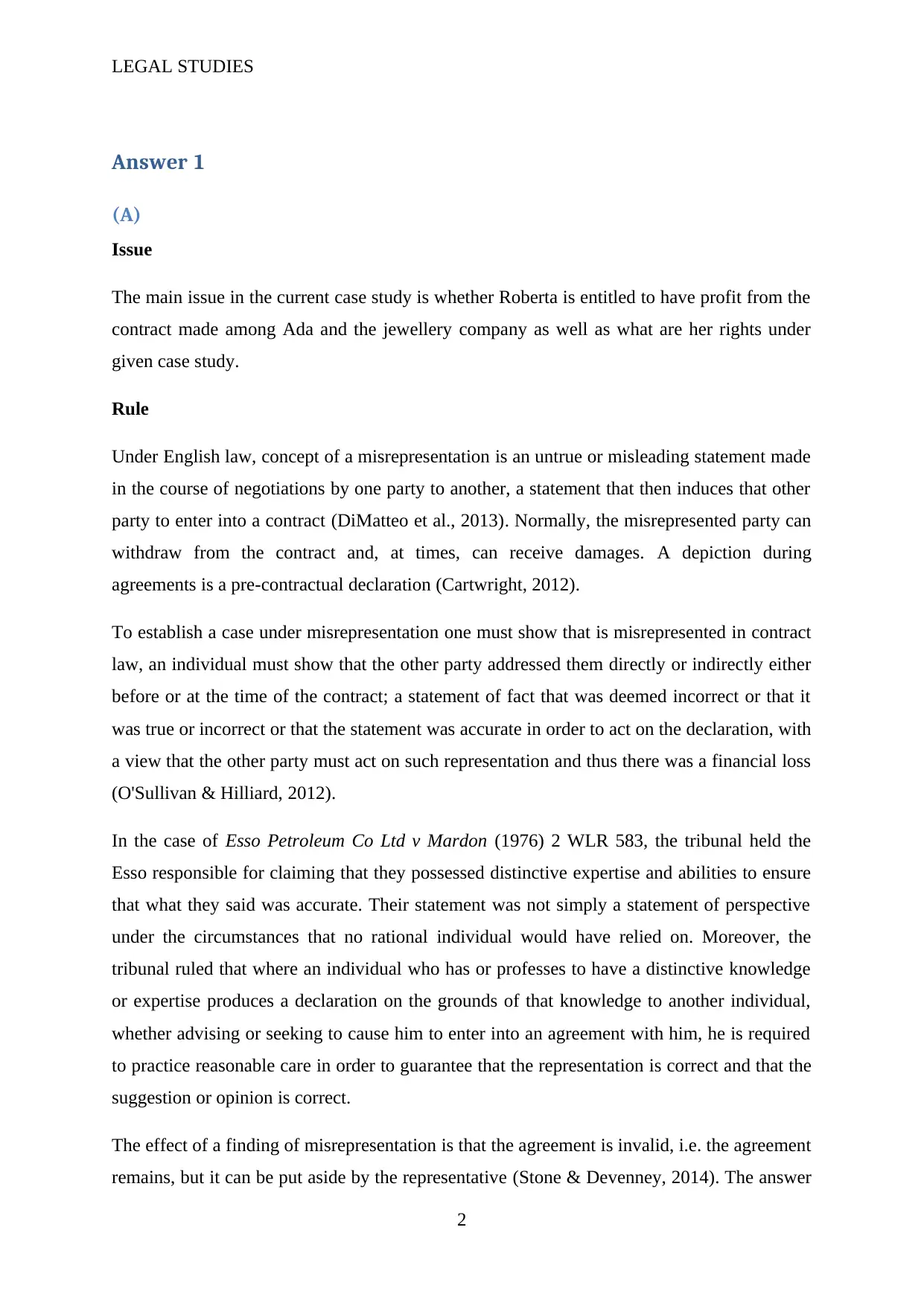
LEGAL STUDIES
Answer 1
(A)
Issue
The main issue in the current case study is whether Roberta is entitled to have profit from the
contract made among Ada and the jewellery company as well as what are her rights under
given case study.
Rule
Under English law, concept of a misrepresentation is an untrue or misleading statement made
in the course of negotiations by one party to another, a statement that then induces that other
party to enter into a contract (DiMatteo et al., 2013). Normally, the misrepresented party can
withdraw from the contract and, at times, can receive damages. A depiction during
agreements is a pre-contractual declaration (Cartwright, 2012).
To establish a case under misrepresentation one must show that is misrepresented in contract
law, an individual must show that the other party addressed them directly or indirectly either
before or at the time of the contract; a statement of fact that was deemed incorrect or that it
was true or incorrect or that the statement was accurate in order to act on the declaration, with
a view that the other party must act on such representation and thus there was a financial loss
(O'Sullivan & Hilliard, 2012).
In the case of Esso Petroleum Co Ltd v Mardon (1976) 2 WLR 583, the tribunal held the
Esso responsible for claiming that they possessed distinctive expertise and abilities to ensure
that what they said was accurate. Their statement was not simply a statement of perspective
under the circumstances that no rational individual would have relied on. Moreover, the
tribunal ruled that where an individual who has or professes to have a distinctive knowledge
or expertise produces a declaration on the grounds of that knowledge to another individual,
whether advising or seeking to cause him to enter into an agreement with him, he is required
to practice reasonable care in order to guarantee that the representation is correct and that the
suggestion or opinion is correct.
The effect of a finding of misrepresentation is that the agreement is invalid, i.e. the agreement
remains, but it can be put aside by the representative (Stone & Devenney, 2014). The answer
2
Answer 1
(A)
Issue
The main issue in the current case study is whether Roberta is entitled to have profit from the
contract made among Ada and the jewellery company as well as what are her rights under
given case study.
Rule
Under English law, concept of a misrepresentation is an untrue or misleading statement made
in the course of negotiations by one party to another, a statement that then induces that other
party to enter into a contract (DiMatteo et al., 2013). Normally, the misrepresented party can
withdraw from the contract and, at times, can receive damages. A depiction during
agreements is a pre-contractual declaration (Cartwright, 2012).
To establish a case under misrepresentation one must show that is misrepresented in contract
law, an individual must show that the other party addressed them directly or indirectly either
before or at the time of the contract; a statement of fact that was deemed incorrect or that it
was true or incorrect or that the statement was accurate in order to act on the declaration, with
a view that the other party must act on such representation and thus there was a financial loss
(O'Sullivan & Hilliard, 2012).
In the case of Esso Petroleum Co Ltd v Mardon (1976) 2 WLR 583, the tribunal held the
Esso responsible for claiming that they possessed distinctive expertise and abilities to ensure
that what they said was accurate. Their statement was not simply a statement of perspective
under the circumstances that no rational individual would have relied on. Moreover, the
tribunal ruled that where an individual who has or professes to have a distinctive knowledge
or expertise produces a declaration on the grounds of that knowledge to another individual,
whether advising or seeking to cause him to enter into an agreement with him, he is required
to practice reasonable care in order to guarantee that the representation is correct and that the
suggestion or opinion is correct.
The effect of a finding of misrepresentation is that the agreement is invalid, i.e. the agreement
remains, but it can be put aside by the representative (Stone & Devenney, 2014). The answer
2
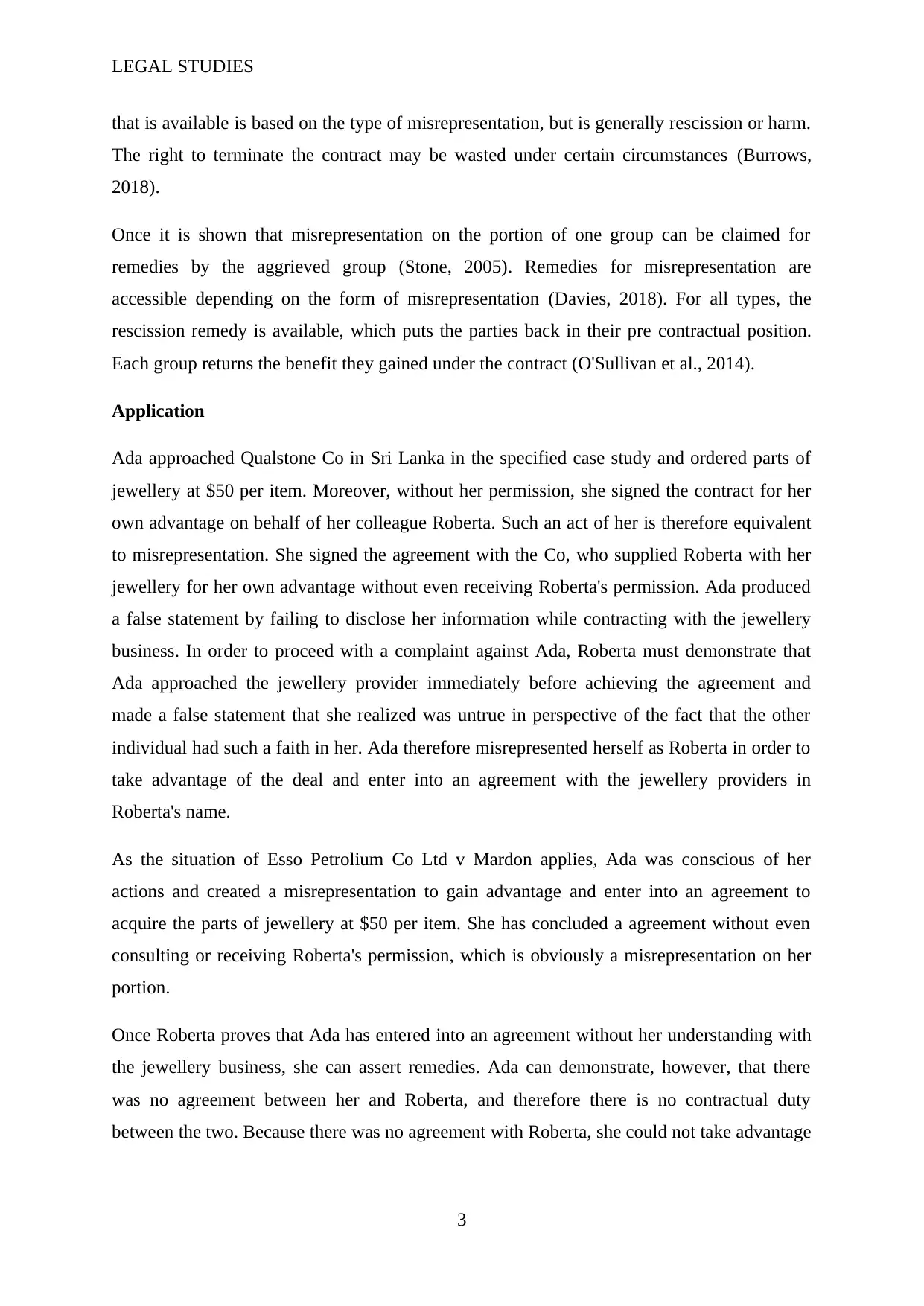
LEGAL STUDIES
that is available is based on the type of misrepresentation, but is generally rescission or harm.
The right to terminate the contract may be wasted under certain circumstances (Burrows,
2018).
Once it is shown that misrepresentation on the portion of one group can be claimed for
remedies by the aggrieved group (Stone, 2005). Remedies for misrepresentation are
accessible depending on the form of misrepresentation (Davies, 2018). For all types, the
rescission remedy is available, which puts the parties back in their pre contractual position.
Each group returns the benefit they gained under the contract (O'Sullivan et al., 2014).
Application
Ada approached Qualstone Co in Sri Lanka in the specified case study and ordered parts of
jewellery at $50 per item. Moreover, without her permission, she signed the contract for her
own advantage on behalf of her colleague Roberta. Such an act of her is therefore equivalent
to misrepresentation. She signed the agreement with the Co, who supplied Roberta with her
jewellery for her own advantage without even receiving Roberta's permission. Ada produced
a false statement by failing to disclose her information while contracting with the jewellery
business. In order to proceed with a complaint against Ada, Roberta must demonstrate that
Ada approached the jewellery provider immediately before achieving the agreement and
made a false statement that she realized was untrue in perspective of the fact that the other
individual had such a faith in her. Ada therefore misrepresented herself as Roberta in order to
take advantage of the deal and enter into an agreement with the jewellery providers in
Roberta's name.
As the situation of Esso Petrolium Co Ltd v Mardon applies, Ada was conscious of her
actions and created a misrepresentation to gain advantage and enter into an agreement to
acquire the parts of jewellery at $50 per item. She has concluded a agreement without even
consulting or receiving Roberta's permission, which is obviously a misrepresentation on her
portion.
Once Roberta proves that Ada has entered into an agreement without her understanding with
the jewellery business, she can assert remedies. Ada can demonstrate, however, that there
was no agreement between her and Roberta, and therefore there is no contractual duty
between the two. Because there was no agreement with Roberta, she could not take advantage
3
that is available is based on the type of misrepresentation, but is generally rescission or harm.
The right to terminate the contract may be wasted under certain circumstances (Burrows,
2018).
Once it is shown that misrepresentation on the portion of one group can be claimed for
remedies by the aggrieved group (Stone, 2005). Remedies for misrepresentation are
accessible depending on the form of misrepresentation (Davies, 2018). For all types, the
rescission remedy is available, which puts the parties back in their pre contractual position.
Each group returns the benefit they gained under the contract (O'Sullivan et al., 2014).
Application
Ada approached Qualstone Co in Sri Lanka in the specified case study and ordered parts of
jewellery at $50 per item. Moreover, without her permission, she signed the contract for her
own advantage on behalf of her colleague Roberta. Such an act of her is therefore equivalent
to misrepresentation. She signed the agreement with the Co, who supplied Roberta with her
jewellery for her own advantage without even receiving Roberta's permission. Ada produced
a false statement by failing to disclose her information while contracting with the jewellery
business. In order to proceed with a complaint against Ada, Roberta must demonstrate that
Ada approached the jewellery provider immediately before achieving the agreement and
made a false statement that she realized was untrue in perspective of the fact that the other
individual had such a faith in her. Ada therefore misrepresented herself as Roberta in order to
take advantage of the deal and enter into an agreement with the jewellery providers in
Roberta's name.
As the situation of Esso Petrolium Co Ltd v Mardon applies, Ada was conscious of her
actions and created a misrepresentation to gain advantage and enter into an agreement to
acquire the parts of jewellery at $50 per item. She has concluded a agreement without even
consulting or receiving Roberta's permission, which is obviously a misrepresentation on her
portion.
Once Roberta proves that Ada has entered into an agreement without her understanding with
the jewellery business, she can assert remedies. Ada can demonstrate, however, that there
was no agreement between her and Roberta, and therefore there is no contractual duty
between the two. Because there was no agreement with Roberta, she could not take advantage
3
Secure Best Marks with AI Grader
Need help grading? Try our AI Grader for instant feedback on your assignments.
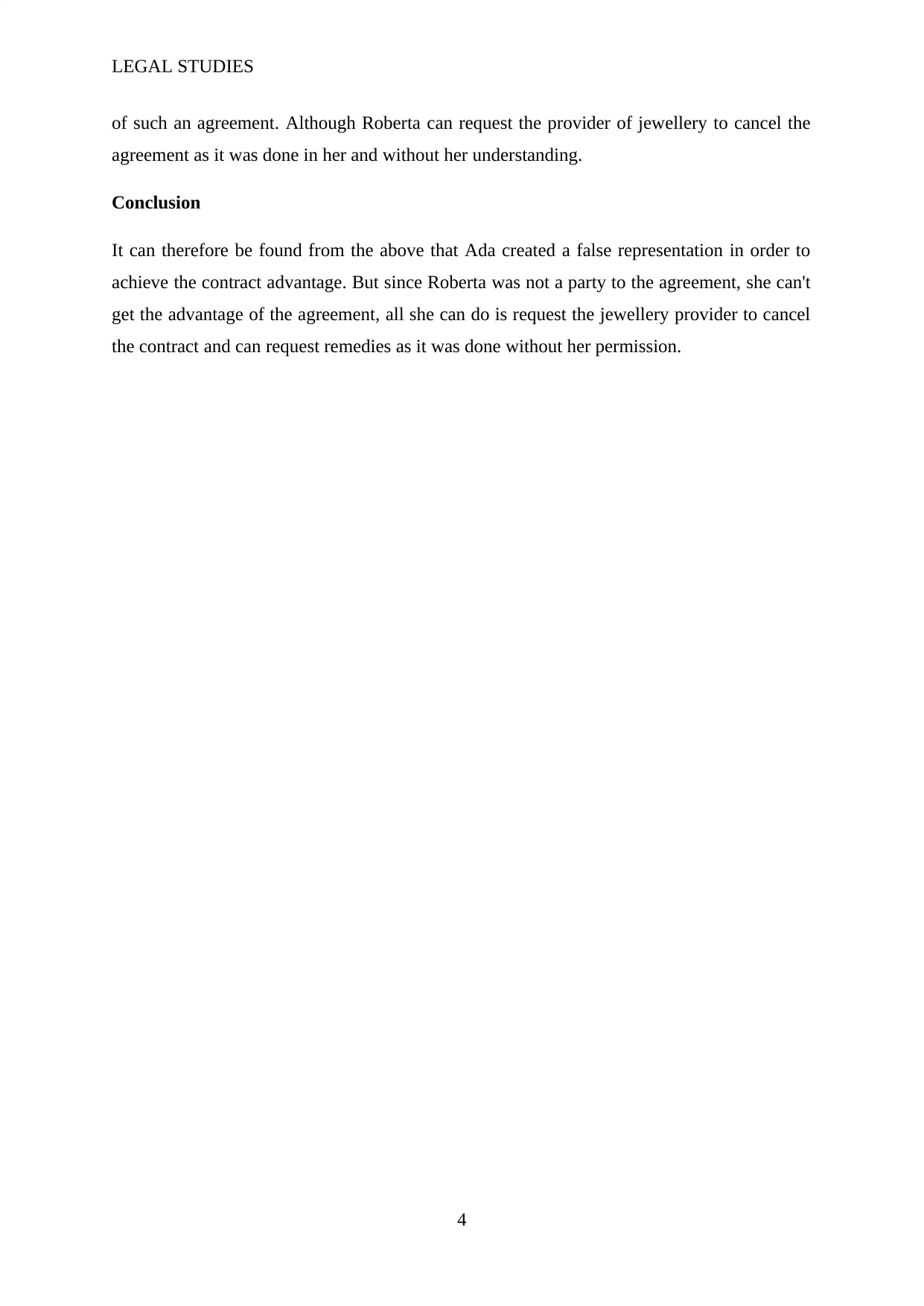
LEGAL STUDIES
of such an agreement. Although Roberta can request the provider of jewellery to cancel the
agreement as it was done in her and without her understanding.
Conclusion
It can therefore be found from the above that Ada created a false representation in order to
achieve the contract advantage. But since Roberta was not a party to the agreement, she can't
get the advantage of the agreement, all she can do is request the jewellery provider to cancel
the contract and can request remedies as it was done without her permission.
4
of such an agreement. Although Roberta can request the provider of jewellery to cancel the
agreement as it was done in her and without her understanding.
Conclusion
It can therefore be found from the above that Ada created a false representation in order to
achieve the contract advantage. But since Roberta was not a party to the agreement, she can't
get the advantage of the agreement, all she can do is request the jewellery provider to cancel
the contract and can request remedies as it was done without her permission.
4
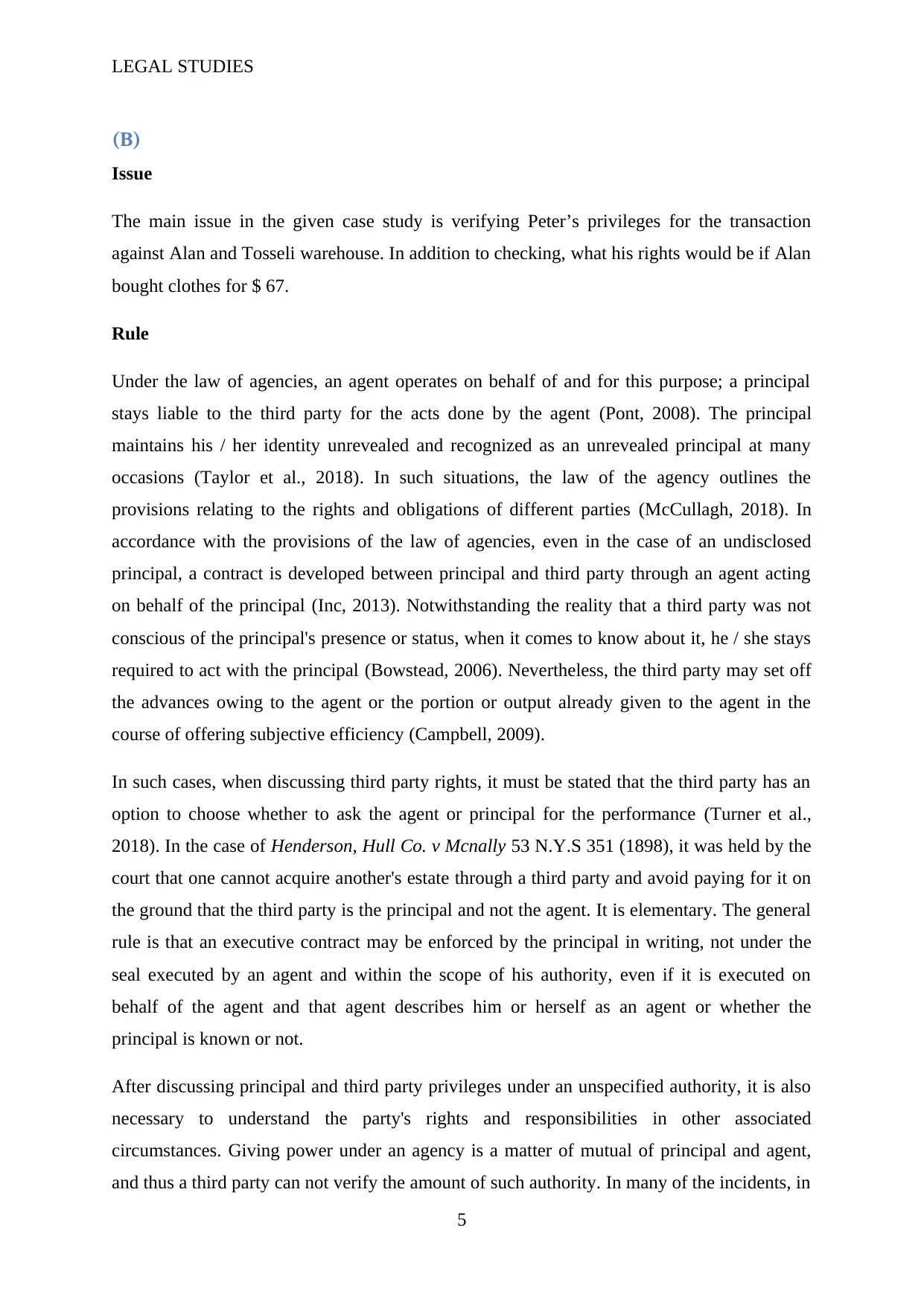
LEGAL STUDIES
(B)
Issue
The main issue in the given case study is verifying Peter’s privileges for the transaction
against Alan and Tosseli warehouse. In addition to checking, what his rights would be if Alan
bought clothes for $ 67.
Rule
Under the law of agencies, an agent operates on behalf of and for this purpose; a principal
stays liable to the third party for the acts done by the agent (Pont, 2008). The principal
maintains his / her identity unrevealed and recognized as an unrevealed principal at many
occasions (Taylor et al., 2018). In such situations, the law of the agency outlines the
provisions relating to the rights and obligations of different parties (McCullagh, 2018). In
accordance with the provisions of the law of agencies, even in the case of an undisclosed
principal, a contract is developed between principal and third party through an agent acting
on behalf of the principal (Inc, 2013). Notwithstanding the reality that a third party was not
conscious of the principal's presence or status, when it comes to know about it, he / she stays
required to act with the principal (Bowstead, 2006). Nevertheless, the third party may set off
the advances owing to the agent or the portion or output already given to the agent in the
course of offering subjective efficiency (Campbell, 2009).
In such cases, when discussing third party rights, it must be stated that the third party has an
option to choose whether to ask the agent or principal for the performance (Turner et al.,
2018). In the case of Henderson, Hull Co. v Mcnally 53 N.Y.S 351 (1898), it was held by the
court that one cannot acquire another's estate through a third party and avoid paying for it on
the ground that the third party is the principal and not the agent. It is elementary. The general
rule is that an executive contract may be enforced by the principal in writing, not under the
seal executed by an agent and within the scope of his authority, even if it is executed on
behalf of the agent and that agent describes him or herself as an agent or whether the
principal is known or not.
After discussing principal and third party privileges under an unspecified authority, it is also
necessary to understand the party's rights and responsibilities in other associated
circumstances. Giving power under an agency is a matter of mutual of principal and agent,
and thus a third party can not verify the amount of such authority. In many of the incidents, in
5
(B)
Issue
The main issue in the given case study is verifying Peter’s privileges for the transaction
against Alan and Tosseli warehouse. In addition to checking, what his rights would be if Alan
bought clothes for $ 67.
Rule
Under the law of agencies, an agent operates on behalf of and for this purpose; a principal
stays liable to the third party for the acts done by the agent (Pont, 2008). The principal
maintains his / her identity unrevealed and recognized as an unrevealed principal at many
occasions (Taylor et al., 2018). In such situations, the law of the agency outlines the
provisions relating to the rights and obligations of different parties (McCullagh, 2018). In
accordance with the provisions of the law of agencies, even in the case of an undisclosed
principal, a contract is developed between principal and third party through an agent acting
on behalf of the principal (Inc, 2013). Notwithstanding the reality that a third party was not
conscious of the principal's presence or status, when it comes to know about it, he / she stays
required to act with the principal (Bowstead, 2006). Nevertheless, the third party may set off
the advances owing to the agent or the portion or output already given to the agent in the
course of offering subjective efficiency (Campbell, 2009).
In such cases, when discussing third party rights, it must be stated that the third party has an
option to choose whether to ask the agent or principal for the performance (Turner et al.,
2018). In the case of Henderson, Hull Co. v Mcnally 53 N.Y.S 351 (1898), it was held by the
court that one cannot acquire another's estate through a third party and avoid paying for it on
the ground that the third party is the principal and not the agent. It is elementary. The general
rule is that an executive contract may be enforced by the principal in writing, not under the
seal executed by an agent and within the scope of his authority, even if it is executed on
behalf of the agent and that agent describes him or herself as an agent or whether the
principal is known or not.
After discussing principal and third party privileges under an unspecified authority, it is also
necessary to understand the party's rights and responsibilities in other associated
circumstances. Giving power under an agency is a matter of mutual of principal and agent,
and thus a third party can not verify the amount of such authority. In many of the incidents, in
5
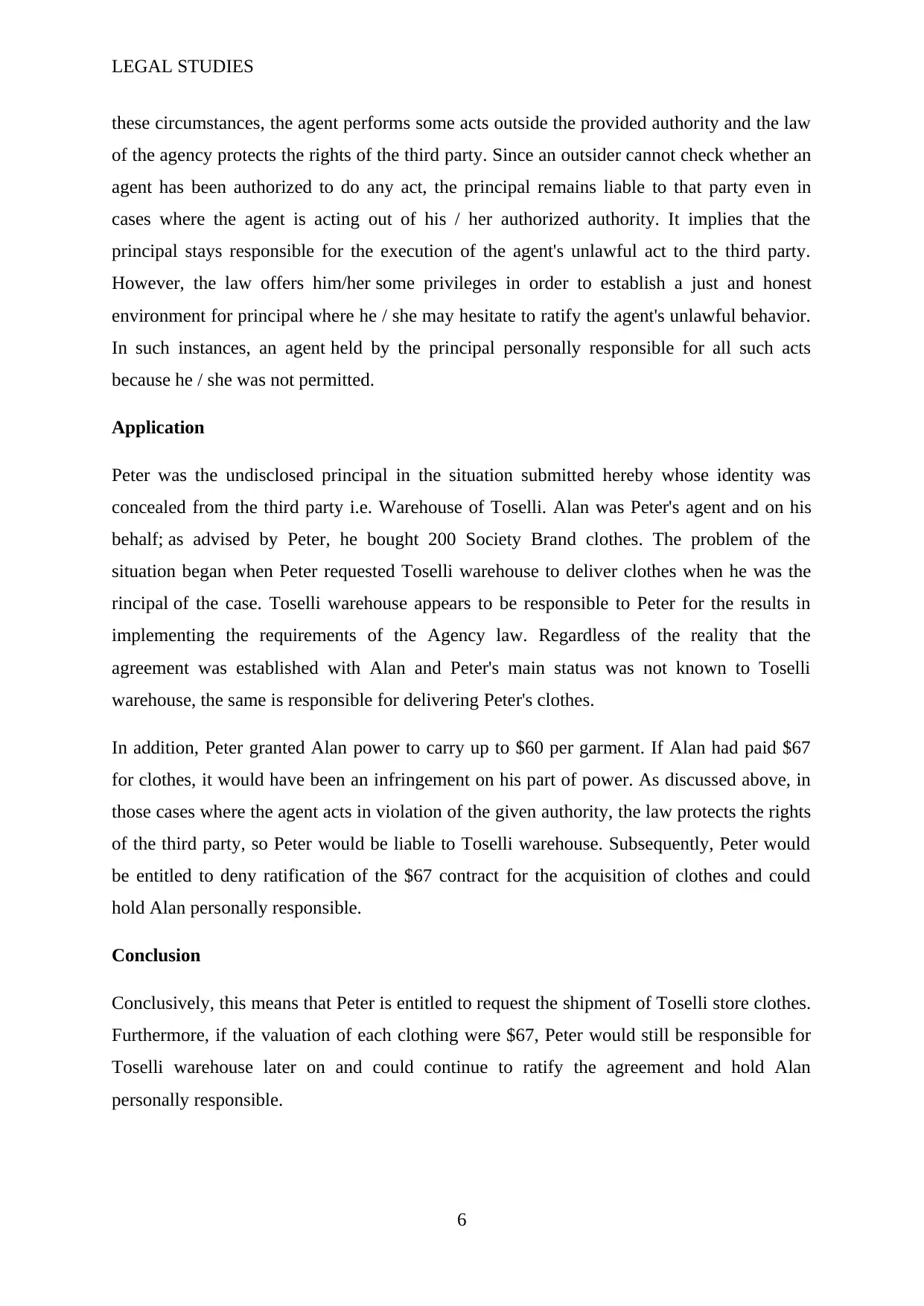
LEGAL STUDIES
these circumstances, the agent performs some acts outside the provided authority and the law
of the agency protects the rights of the third party. Since an outsider cannot check whether an
agent has been authorized to do any act, the principal remains liable to that party even in
cases where the agent is acting out of his / her authorized authority. It implies that the
principal stays responsible for the execution of the agent's unlawful act to the third party.
However, the law offers him/her some privileges in order to establish a just and honest
environment for principal where he / she may hesitate to ratify the agent's unlawful behavior.
In such instances, an agent held by the principal personally responsible for all such acts
because he / she was not permitted.
Application
Peter was the undisclosed principal in the situation submitted hereby whose identity was
concealed from the third party i.e. Warehouse of Toselli. Alan was Peter's agent and on his
behalf; as advised by Peter, he bought 200 Society Brand clothes. The problem of the
situation began when Peter requested Toselli warehouse to deliver clothes when he was the
rincipal of the case. Toselli warehouse appears to be responsible to Peter for the results in
implementing the requirements of the Agency law. Regardless of the reality that the
agreement was established with Alan and Peter's main status was not known to Toselli
warehouse, the same is responsible for delivering Peter's clothes.
In addition, Peter granted Alan power to carry up to $60 per garment. If Alan had paid $67
for clothes, it would have been an infringement on his part of power. As discussed above, in
those cases where the agent acts in violation of the given authority, the law protects the rights
of the third party, so Peter would be liable to Toselli warehouse. Subsequently, Peter would
be entitled to deny ratification of the $67 contract for the acquisition of clothes and could
hold Alan personally responsible.
Conclusion
Conclusively, this means that Peter is entitled to request the shipment of Toselli store clothes.
Furthermore, if the valuation of each clothing were $67, Peter would still be responsible for
Toselli warehouse later on and could continue to ratify the agreement and hold Alan
personally responsible.
6
these circumstances, the agent performs some acts outside the provided authority and the law
of the agency protects the rights of the third party. Since an outsider cannot check whether an
agent has been authorized to do any act, the principal remains liable to that party even in
cases where the agent is acting out of his / her authorized authority. It implies that the
principal stays responsible for the execution of the agent's unlawful act to the third party.
However, the law offers him/her some privileges in order to establish a just and honest
environment for principal where he / she may hesitate to ratify the agent's unlawful behavior.
In such instances, an agent held by the principal personally responsible for all such acts
because he / she was not permitted.
Application
Peter was the undisclosed principal in the situation submitted hereby whose identity was
concealed from the third party i.e. Warehouse of Toselli. Alan was Peter's agent and on his
behalf; as advised by Peter, he bought 200 Society Brand clothes. The problem of the
situation began when Peter requested Toselli warehouse to deliver clothes when he was the
rincipal of the case. Toselli warehouse appears to be responsible to Peter for the results in
implementing the requirements of the Agency law. Regardless of the reality that the
agreement was established with Alan and Peter's main status was not known to Toselli
warehouse, the same is responsible for delivering Peter's clothes.
In addition, Peter granted Alan power to carry up to $60 per garment. If Alan had paid $67
for clothes, it would have been an infringement on his part of power. As discussed above, in
those cases where the agent acts in violation of the given authority, the law protects the rights
of the third party, so Peter would be liable to Toselli warehouse. Subsequently, Peter would
be entitled to deny ratification of the $67 contract for the acquisition of clothes and could
hold Alan personally responsible.
Conclusion
Conclusively, this means that Peter is entitled to request the shipment of Toselli store clothes.
Furthermore, if the valuation of each clothing were $67, Peter would still be responsible for
Toselli warehouse later on and could continue to ratify the agreement and hold Alan
personally responsible.
6
Paraphrase This Document
Need a fresh take? Get an instant paraphrase of this document with our AI Paraphraser
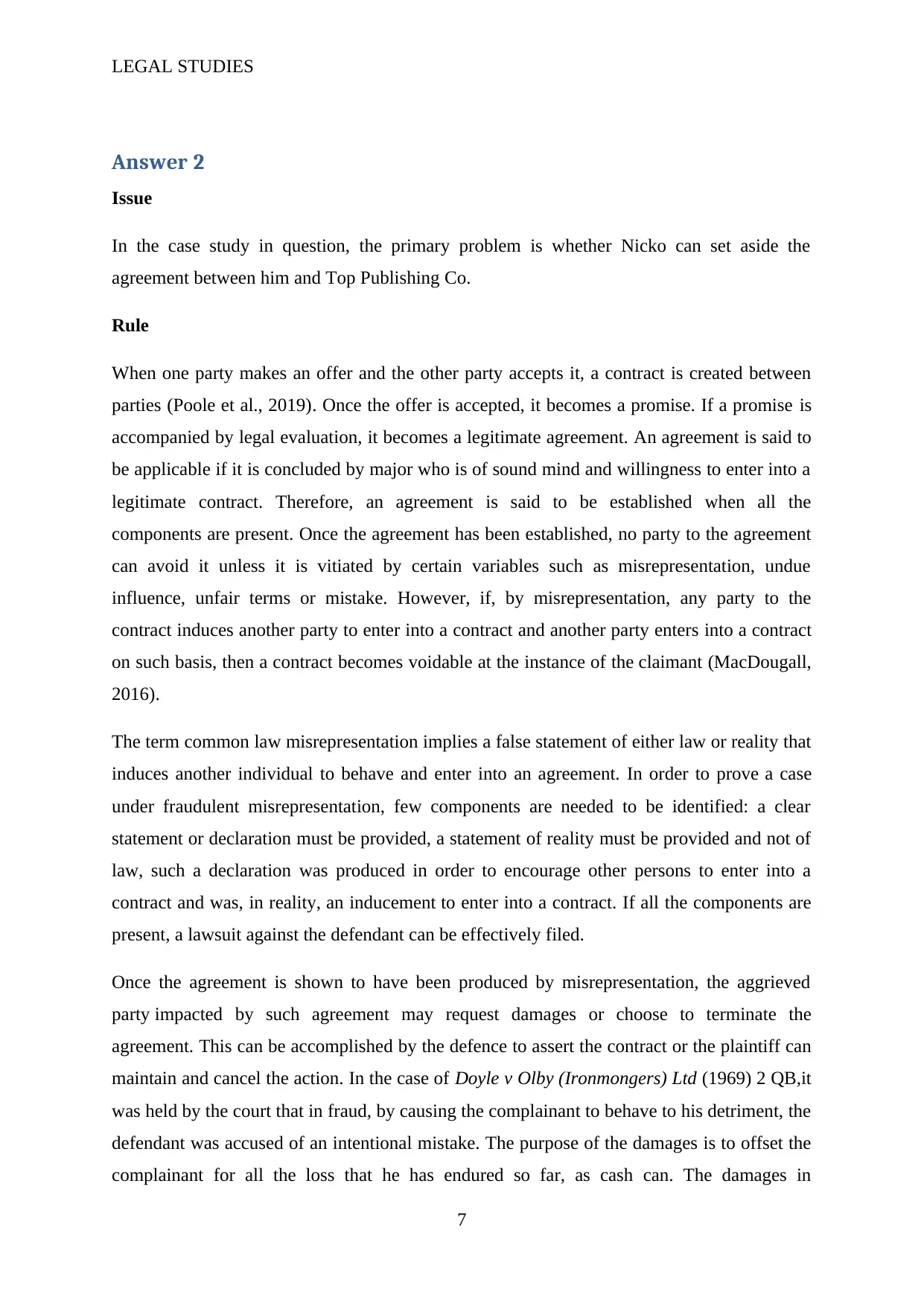
LEGAL STUDIES
Answer 2
Issue
In the case study in question, the primary problem is whether Nicko can set aside the
agreement between him and Top Publishing Co.
Rule
When one party makes an offer and the other party accepts it, a contract is created between
parties (Poole et al., 2019). Once the offer is accepted, it becomes a promise. If a promise is
accompanied by legal evaluation, it becomes a legitimate agreement. An agreement is said to
be applicable if it is concluded by major who is of sound mind and willingness to enter into a
legitimate contract. Therefore, an agreement is said to be established when all the
components are present. Once the agreement has been established, no party to the agreement
can avoid it unless it is vitiated by certain variables such as misrepresentation, undue
influence, unfair terms or mistake. However, if, by misrepresentation, any party to the
contract induces another party to enter into a contract and another party enters into a contract
on such basis, then a contract becomes voidable at the instance of the claimant (MacDougall,
2016).
The term common law misrepresentation implies a false statement of either law or reality that
induces another individual to behave and enter into an agreement. In order to prove a case
under fraudulent misrepresentation, few components are needed to be identified: a clear
statement or declaration must be provided, a statement of reality must be provided and not of
law, such a declaration was produced in order to encourage other persons to enter into a
contract and was, in reality, an inducement to enter into a contract. If all the components are
present, a lawsuit against the defendant can be effectively filed.
Once the agreement is shown to have been produced by misrepresentation, the aggrieved
party impacted by such agreement may request damages or choose to terminate the
agreement. This can be accomplished by the defence to assert the contract or the plaintiff can
maintain and cancel the action. In the case of Doyle v Olby (Ironmongers) Ltd (1969) 2 QB,it
was held by the court that in fraud, by causing the complainant to behave to his detriment, the
defendant was accused of an intentional mistake. The purpose of the damages is to offset the
complainant for all the loss that he has endured so far, as cash can. The damages in
7
Answer 2
Issue
In the case study in question, the primary problem is whether Nicko can set aside the
agreement between him and Top Publishing Co.
Rule
When one party makes an offer and the other party accepts it, a contract is created between
parties (Poole et al., 2019). Once the offer is accepted, it becomes a promise. If a promise is
accompanied by legal evaluation, it becomes a legitimate agreement. An agreement is said to
be applicable if it is concluded by major who is of sound mind and willingness to enter into a
legitimate contract. Therefore, an agreement is said to be established when all the
components are present. Once the agreement has been established, no party to the agreement
can avoid it unless it is vitiated by certain variables such as misrepresentation, undue
influence, unfair terms or mistake. However, if, by misrepresentation, any party to the
contract induces another party to enter into a contract and another party enters into a contract
on such basis, then a contract becomes voidable at the instance of the claimant (MacDougall,
2016).
The term common law misrepresentation implies a false statement of either law or reality that
induces another individual to behave and enter into an agreement. In order to prove a case
under fraudulent misrepresentation, few components are needed to be identified: a clear
statement or declaration must be provided, a statement of reality must be provided and not of
law, such a declaration was produced in order to encourage other persons to enter into a
contract and was, in reality, an inducement to enter into a contract. If all the components are
present, a lawsuit against the defendant can be effectively filed.
Once the agreement is shown to have been produced by misrepresentation, the aggrieved
party impacted by such agreement may request damages or choose to terminate the
agreement. This can be accomplished by the defence to assert the contract or the plaintiff can
maintain and cancel the action. In the case of Doyle v Olby (Ironmongers) Ltd (1969) 2 QB,it
was held by the court that in fraud, by causing the complainant to behave to his detriment, the
defendant was accused of an intentional mistake. The purpose of the damages is to offset the
complainant for all the loss that he has endured so far, as cash can. The damages in
7
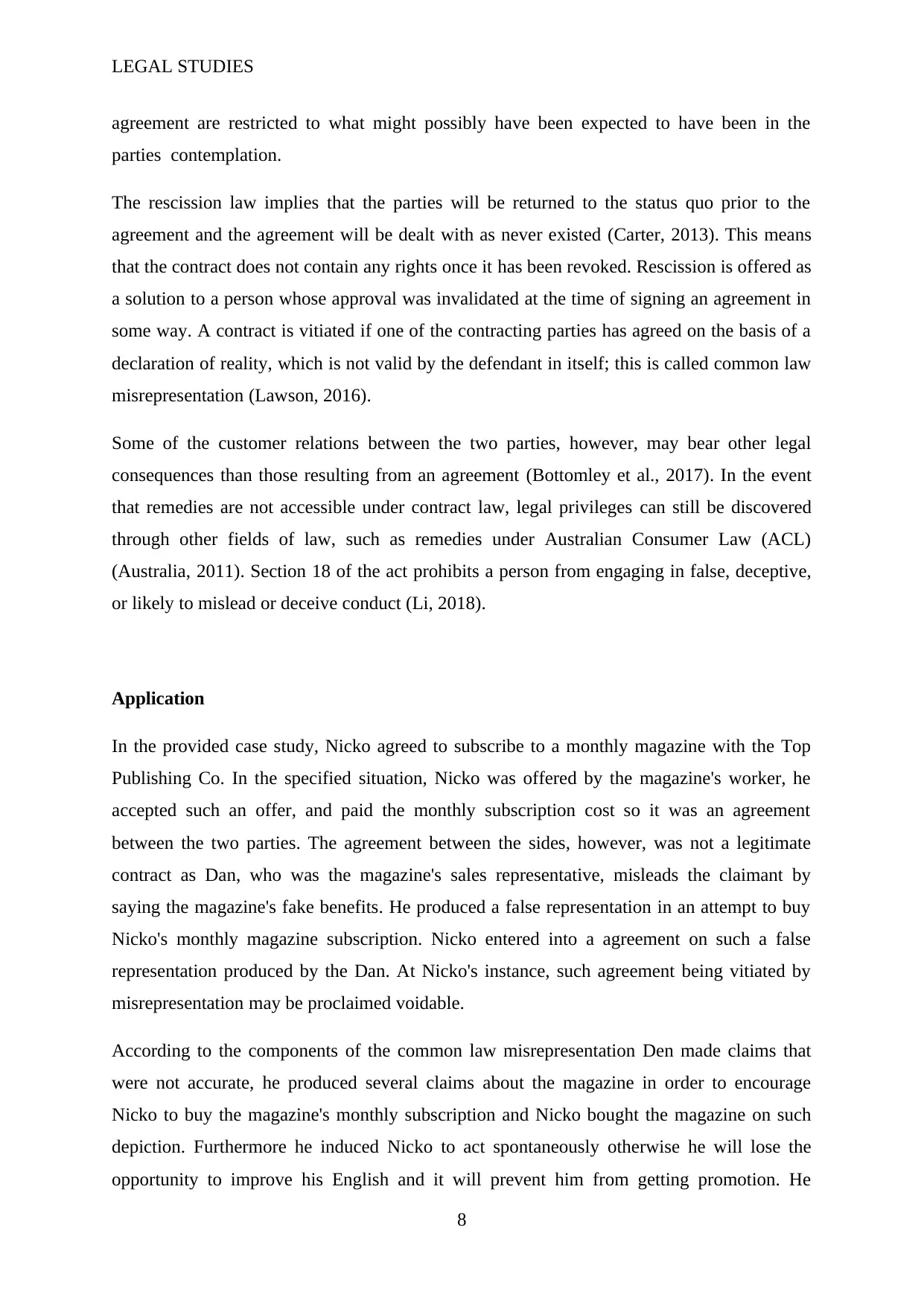
LEGAL STUDIES
agreement are restricted to what might possibly have been expected to have been in the
parties contemplation.
The rescission law implies that the parties will be returned to the status quo prior to the
agreement and the agreement will be dealt with as never existed (Carter, 2013). This means
that the contract does not contain any rights once it has been revoked. Rescission is offered as
a solution to a person whose approval was invalidated at the time of signing an agreement in
some way. A contract is vitiated if one of the contracting parties has agreed on the basis of a
declaration of reality, which is not valid by the defendant in itself; this is called common law
misrepresentation (Lawson, 2016).
Some of the customer relations between the two parties, however, may bear other legal
consequences than those resulting from an agreement (Bottomley et al., 2017). In the event
that remedies are not accessible under contract law, legal privileges can still be discovered
through other fields of law, such as remedies under Australian Consumer Law (ACL)
(Australia, 2011). Section 18 of the act prohibits a person from engaging in false, deceptive,
or likely to mislead or deceive conduct (Li, 2018).
Application
In the provided case study, Nicko agreed to subscribe to a monthly magazine with the Top
Publishing Co. In the specified situation, Nicko was offered by the magazine's worker, he
accepted such an offer, and paid the monthly subscription cost so it was an agreement
between the two parties. The agreement between the sides, however, was not a legitimate
contract as Dan, who was the magazine's sales representative, misleads the claimant by
saying the magazine's fake benefits. He produced a false representation in an attempt to buy
Nicko's monthly magazine subscription. Nicko entered into a agreement on such a false
representation produced by the Dan. At Nicko's instance, such agreement being vitiated by
misrepresentation may be proclaimed voidable.
According to the components of the common law misrepresentation Den made claims that
were not accurate, he produced several claims about the magazine in order to encourage
Nicko to buy the magazine's monthly subscription and Nicko bought the magazine on such
depiction. Furthermore he induced Nicko to act spontaneously otherwise he will lose the
opportunity to improve his English and it will prevent him from getting promotion. He
8
agreement are restricted to what might possibly have been expected to have been in the
parties contemplation.
The rescission law implies that the parties will be returned to the status quo prior to the
agreement and the agreement will be dealt with as never existed (Carter, 2013). This means
that the contract does not contain any rights once it has been revoked. Rescission is offered as
a solution to a person whose approval was invalidated at the time of signing an agreement in
some way. A contract is vitiated if one of the contracting parties has agreed on the basis of a
declaration of reality, which is not valid by the defendant in itself; this is called common law
misrepresentation (Lawson, 2016).
Some of the customer relations between the two parties, however, may bear other legal
consequences than those resulting from an agreement (Bottomley et al., 2017). In the event
that remedies are not accessible under contract law, legal privileges can still be discovered
through other fields of law, such as remedies under Australian Consumer Law (ACL)
(Australia, 2011). Section 18 of the act prohibits a person from engaging in false, deceptive,
or likely to mislead or deceive conduct (Li, 2018).
Application
In the provided case study, Nicko agreed to subscribe to a monthly magazine with the Top
Publishing Co. In the specified situation, Nicko was offered by the magazine's worker, he
accepted such an offer, and paid the monthly subscription cost so it was an agreement
between the two parties. The agreement between the sides, however, was not a legitimate
contract as Dan, who was the magazine's sales representative, misleads the claimant by
saying the magazine's fake benefits. He produced a false representation in an attempt to buy
Nicko's monthly magazine subscription. Nicko entered into a agreement on such a false
representation produced by the Dan. At Nicko's instance, such agreement being vitiated by
misrepresentation may be proclaimed voidable.
According to the components of the common law misrepresentation Den made claims that
were not accurate, he produced several claims about the magazine in order to encourage
Nicko to buy the magazine's monthly subscription and Nicko bought the magazine on such
depiction. Furthermore he induced Nicko to act spontaneously otherwise he will lose the
opportunity to improve his English and it will prevent him from getting promotion. He
8
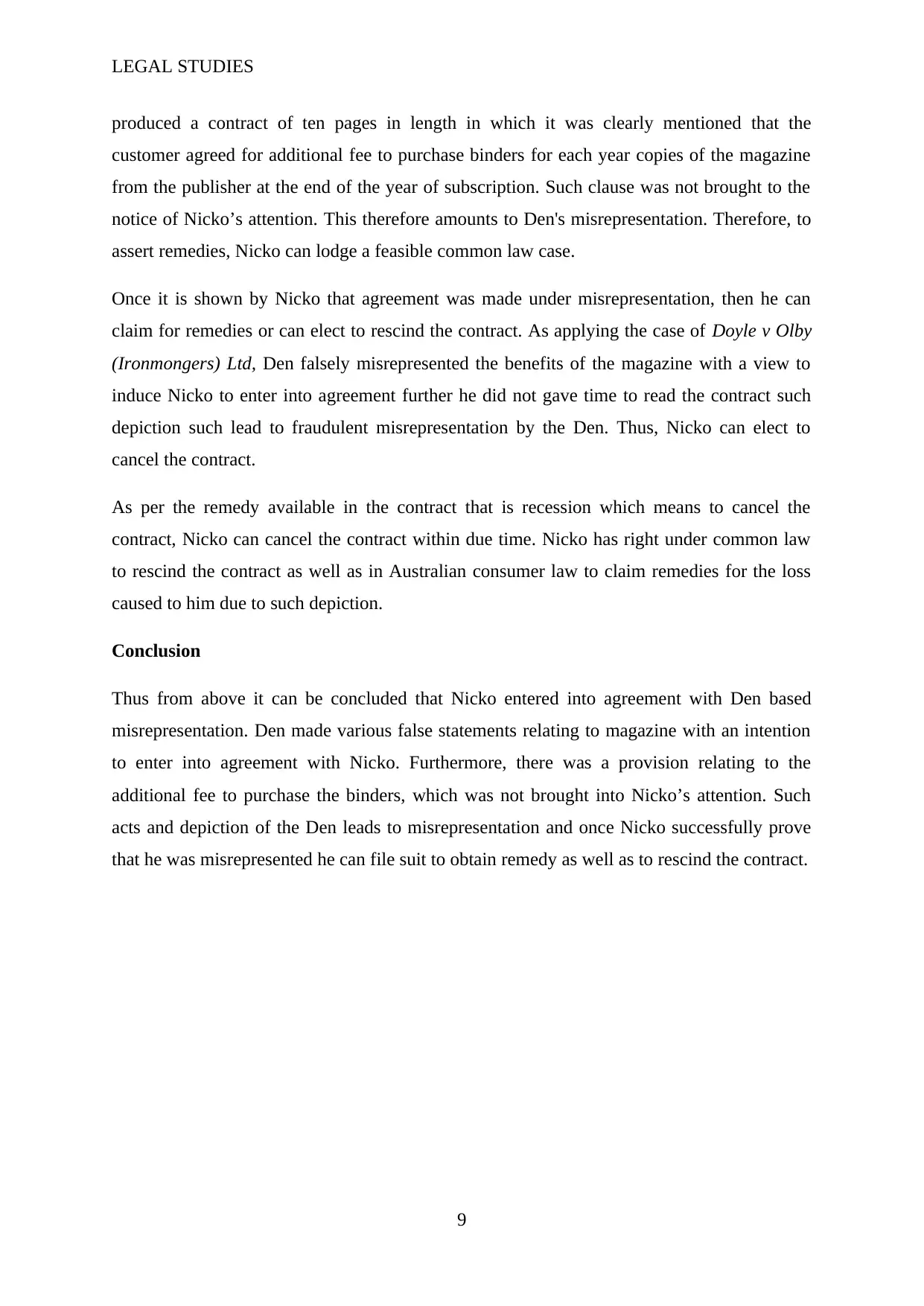
LEGAL STUDIES
produced a contract of ten pages in length in which it was clearly mentioned that the
customer agreed for additional fee to purchase binders for each year copies of the magazine
from the publisher at the end of the year of subscription. Such clause was not brought to the
notice of Nicko’s attention. This therefore amounts to Den's misrepresentation. Therefore, to
assert remedies, Nicko can lodge a feasible common law case.
Once it is shown by Nicko that agreement was made under misrepresentation, then he can
claim for remedies or can elect to rescind the contract. As applying the case of Doyle v Olby
(Ironmongers) Ltd, Den falsely misrepresented the benefits of the magazine with a view to
induce Nicko to enter into agreement further he did not gave time to read the contract such
depiction such lead to fraudulent misrepresentation by the Den. Thus, Nicko can elect to
cancel the contract.
As per the remedy available in the contract that is recession which means to cancel the
contract, Nicko can cancel the contract within due time. Nicko has right under common law
to rescind the contract as well as in Australian consumer law to claim remedies for the loss
caused to him due to such depiction.
Conclusion
Thus from above it can be concluded that Nicko entered into agreement with Den based
misrepresentation. Den made various false statements relating to magazine with an intention
to enter into agreement with Nicko. Furthermore, there was a provision relating to the
additional fee to purchase the binders, which was not brought into Nicko’s attention. Such
acts and depiction of the Den leads to misrepresentation and once Nicko successfully prove
that he was misrepresented he can file suit to obtain remedy as well as to rescind the contract.
9
produced a contract of ten pages in length in which it was clearly mentioned that the
customer agreed for additional fee to purchase binders for each year copies of the magazine
from the publisher at the end of the year of subscription. Such clause was not brought to the
notice of Nicko’s attention. This therefore amounts to Den's misrepresentation. Therefore, to
assert remedies, Nicko can lodge a feasible common law case.
Once it is shown by Nicko that agreement was made under misrepresentation, then he can
claim for remedies or can elect to rescind the contract. As applying the case of Doyle v Olby
(Ironmongers) Ltd, Den falsely misrepresented the benefits of the magazine with a view to
induce Nicko to enter into agreement further he did not gave time to read the contract such
depiction such lead to fraudulent misrepresentation by the Den. Thus, Nicko can elect to
cancel the contract.
As per the remedy available in the contract that is recession which means to cancel the
contract, Nicko can cancel the contract within due time. Nicko has right under common law
to rescind the contract as well as in Australian consumer law to claim remedies for the loss
caused to him due to such depiction.
Conclusion
Thus from above it can be concluded that Nicko entered into agreement with Den based
misrepresentation. Den made various false statements relating to magazine with an intention
to enter into agreement with Nicko. Furthermore, there was a provision relating to the
additional fee to purchase the binders, which was not brought into Nicko’s attention. Such
acts and depiction of the Den leads to misrepresentation and once Nicko successfully prove
that he was misrepresented he can file suit to obtain remedy as well as to rescind the contract.
9
Secure Best Marks with AI Grader
Need help grading? Try our AI Grader for instant feedback on your assignments.
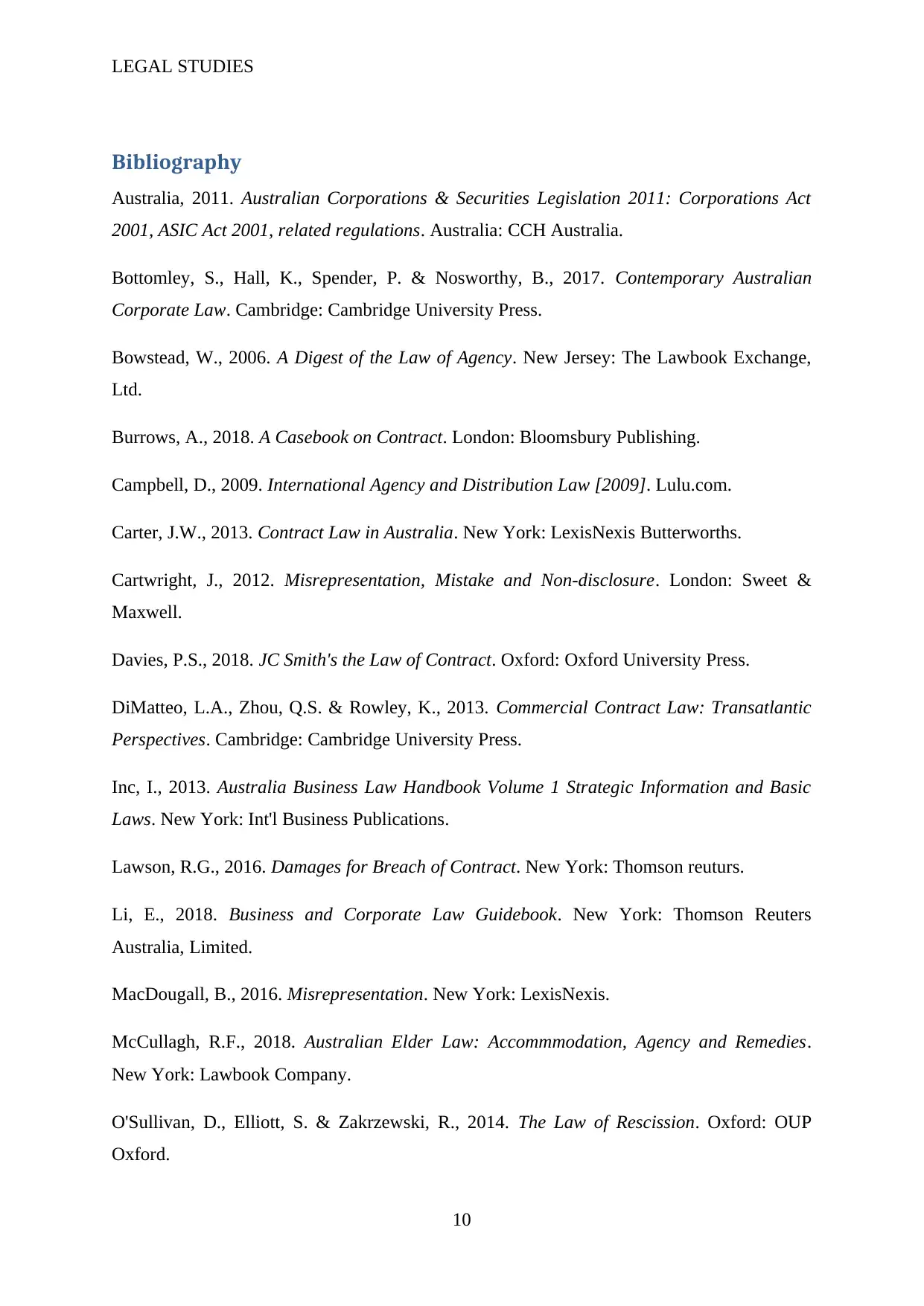
LEGAL STUDIES
Bibliography
Australia, 2011. Australian Corporations & Securities Legislation 2011: Corporations Act
2001, ASIC Act 2001, related regulations. Australia: CCH Australia.
Bottomley, S., Hall, K., Spender, P. & Nosworthy, B., 2017. Contemporary Australian
Corporate Law. Cambridge: Cambridge University Press.
Bowstead, W., 2006. A Digest of the Law of Agency. New Jersey: The Lawbook Exchange,
Ltd.
Burrows, A., 2018. A Casebook on Contract. London: Bloomsbury Publishing.
Campbell, D., 2009. International Agency and Distribution Law [2009]. Lulu.com.
Carter, J.W., 2013. Contract Law in Australia. New York: LexisNexis Butterworths.
Cartwright, J., 2012. Misrepresentation, Mistake and Non-disclosure. London: Sweet &
Maxwell.
Davies, P.S., 2018. JC Smith's the Law of Contract. Oxford: Oxford University Press.
DiMatteo, L.A., Zhou, Q.S. & Rowley, K., 2013. Commercial Contract Law: Transatlantic
Perspectives. Cambridge: Cambridge University Press.
Inc, I., 2013. Australia Business Law Handbook Volume 1 Strategic Information and Basic
Laws. New York: Int'l Business Publications.
Lawson, R.G., 2016. Damages for Breach of Contract. New York: Thomson reuturs.
Li, E., 2018. Business and Corporate Law Guidebook. New York: Thomson Reuters
Australia, Limited.
MacDougall, B., 2016. Misrepresentation. New York: LexisNexis.
McCullagh, R.F., 2018. Australian Elder Law: Accommmodation, Agency and Remedies.
New York: Lawbook Company.
O'Sullivan, D., Elliott, S. & Zakrzewski, R., 2014. The Law of Rescission. Oxford: OUP
Oxford.
10
Bibliography
Australia, 2011. Australian Corporations & Securities Legislation 2011: Corporations Act
2001, ASIC Act 2001, related regulations. Australia: CCH Australia.
Bottomley, S., Hall, K., Spender, P. & Nosworthy, B., 2017. Contemporary Australian
Corporate Law. Cambridge: Cambridge University Press.
Bowstead, W., 2006. A Digest of the Law of Agency. New Jersey: The Lawbook Exchange,
Ltd.
Burrows, A., 2018. A Casebook on Contract. London: Bloomsbury Publishing.
Campbell, D., 2009. International Agency and Distribution Law [2009]. Lulu.com.
Carter, J.W., 2013. Contract Law in Australia. New York: LexisNexis Butterworths.
Cartwright, J., 2012. Misrepresentation, Mistake and Non-disclosure. London: Sweet &
Maxwell.
Davies, P.S., 2018. JC Smith's the Law of Contract. Oxford: Oxford University Press.
DiMatteo, L.A., Zhou, Q.S. & Rowley, K., 2013. Commercial Contract Law: Transatlantic
Perspectives. Cambridge: Cambridge University Press.
Inc, I., 2013. Australia Business Law Handbook Volume 1 Strategic Information and Basic
Laws. New York: Int'l Business Publications.
Lawson, R.G., 2016. Damages for Breach of Contract. New York: Thomson reuturs.
Li, E., 2018. Business and Corporate Law Guidebook. New York: Thomson Reuters
Australia, Limited.
MacDougall, B., 2016. Misrepresentation. New York: LexisNexis.
McCullagh, R.F., 2018. Australian Elder Law: Accommmodation, Agency and Remedies.
New York: Lawbook Company.
O'Sullivan, D., Elliott, S. & Zakrzewski, R., 2014. The Law of Rescission. Oxford: OUP
Oxford.
10
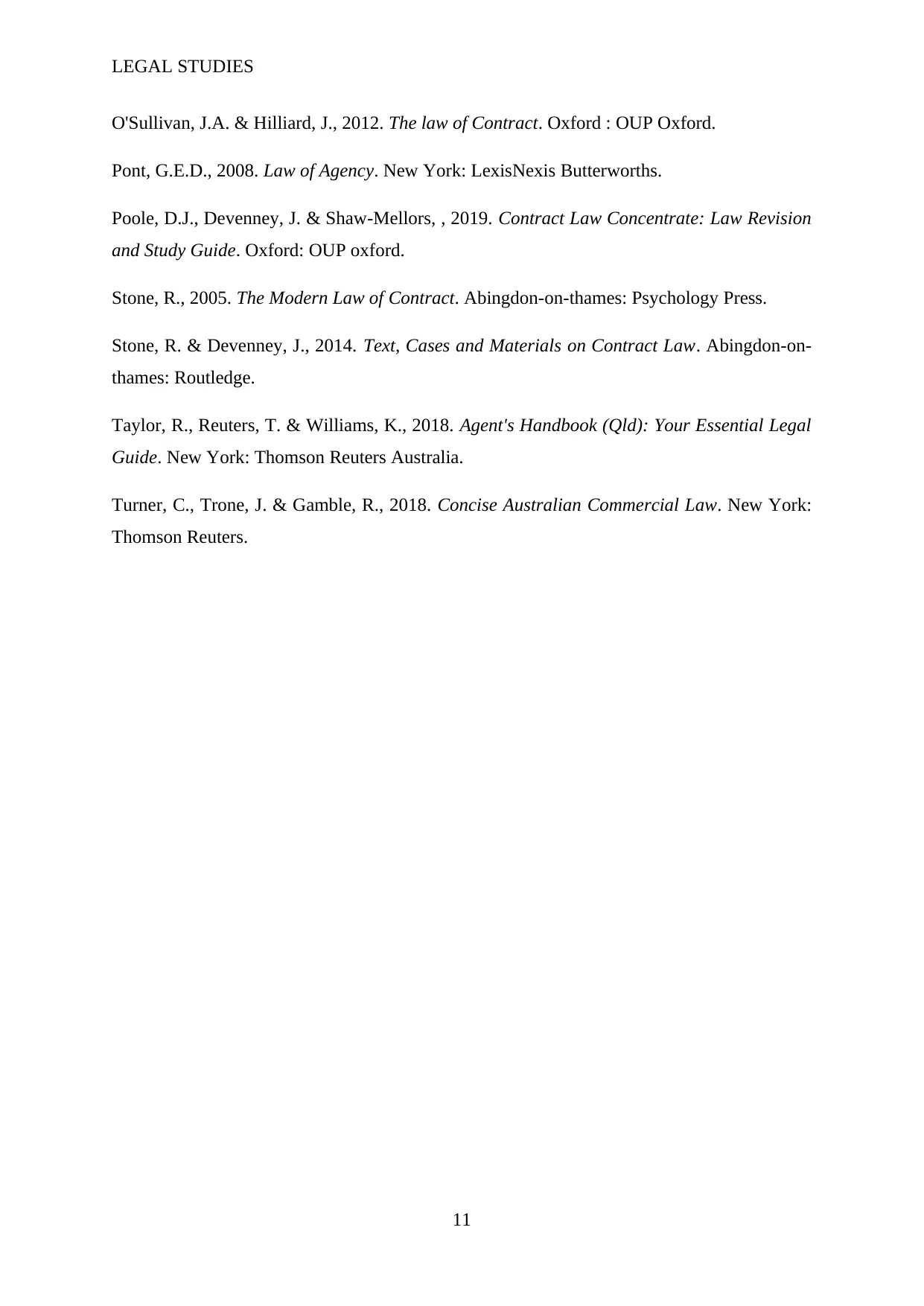
LEGAL STUDIES
O'Sullivan, J.A. & Hilliard, J., 2012. The law of Contract. Oxford : OUP Oxford.
Pont, G.E.D., 2008. Law of Agency. New York: LexisNexis Butterworths.
Poole, D.J., Devenney, J. & Shaw-Mellors, , 2019. Contract Law Concentrate: Law Revision
and Study Guide. Oxford: OUP oxford.
Stone, R., 2005. The Modern Law of Contract. Abingdon-on-thames: Psychology Press.
Stone, R. & Devenney, J., 2014. Text, Cases and Materials on Contract Law. Abingdon-on-
thames: Routledge.
Taylor, R., Reuters, T. & Williams, K., 2018. Agent's Handbook (Qld): Your Essential Legal
Guide. New York: Thomson Reuters Australia.
Turner, C., Trone, J. & Gamble, R., 2018. Concise Australian Commercial Law. New York:
Thomson Reuters.
11
O'Sullivan, J.A. & Hilliard, J., 2012. The law of Contract. Oxford : OUP Oxford.
Pont, G.E.D., 2008. Law of Agency. New York: LexisNexis Butterworths.
Poole, D.J., Devenney, J. & Shaw-Mellors, , 2019. Contract Law Concentrate: Law Revision
and Study Guide. Oxford: OUP oxford.
Stone, R., 2005. The Modern Law of Contract. Abingdon-on-thames: Psychology Press.
Stone, R. & Devenney, J., 2014. Text, Cases and Materials on Contract Law. Abingdon-on-
thames: Routledge.
Taylor, R., Reuters, T. & Williams, K., 2018. Agent's Handbook (Qld): Your Essential Legal
Guide. New York: Thomson Reuters Australia.
Turner, C., Trone, J. & Gamble, R., 2018. Concise Australian Commercial Law. New York:
Thomson Reuters.
11
1 out of 12
Related Documents
Your All-in-One AI-Powered Toolkit for Academic Success.
+13062052269
info@desklib.com
Available 24*7 on WhatsApp / Email
![[object Object]](/_next/static/media/star-bottom.7253800d.svg)
Unlock your academic potential
© 2024 | Zucol Services PVT LTD | All rights reserved.





